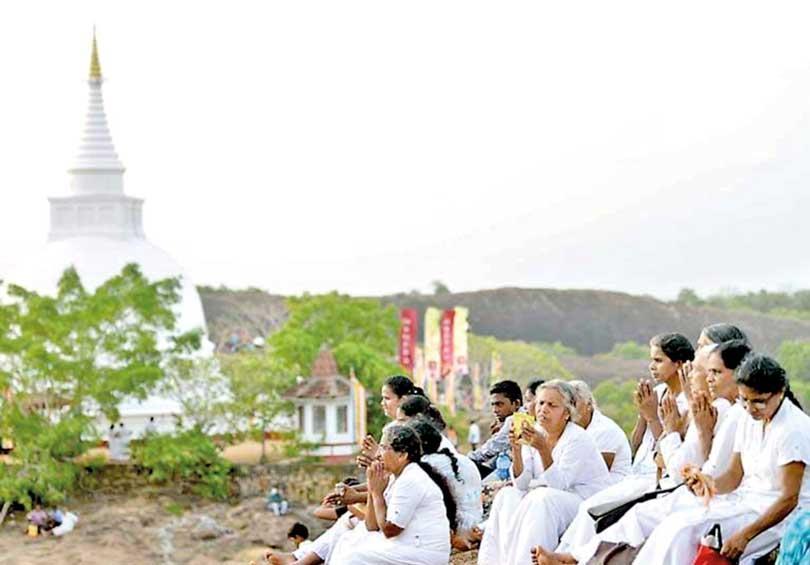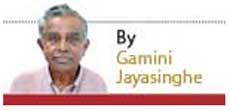03 Jun 2023 - {{hitsCtrl.values.hits}}

Devotees attend the Poson Poya celebrations at the Thanthirimale Temple organised by Wijeya Newspapers. - Pic by Shantha Ratnayake
 The historical Thanthirimale Raja Maha Viharaya claiming for a civilization running back to the period before the introduction of Buddhism to Sri Lanka is situated in the picturesque valley of Malwathuoya, about thirty miles away from Anuradhapura.
The historical Thanthirimale Raja Maha Viharaya claiming for a civilization running back to the period before the introduction of Buddhism to Sri Lanka is situated in the picturesque valley of Malwathuoya, about thirty miles away from Anuradhapura.
The ancient glory and serenity of Thanthirimale are revived when the whole temple area is illuminated annually by Wijeya Newspapers Ltd during the Poson season.
According to the learned persons like Hokart there was a developed civilization in Thanthirimale as far from the pre historic period. Among the very important ruins recovered not only from Thanthirimale, but also from the rocks in the surrounding area such as Billewa and Andiyagala there are some paintings by pre historic inhabitants in the area. Paintings relate to the day to day lives of the people including the pictures of tigers, peacocks and buffaloes; found in these caves.
The recorded history of Thanthirimale begins from the time when Buddhism was introduced to Sri Lanka during the third century B.C. King Devananpiyatissa mentioned in the chronicle Mahawansa as “Pruthuviswara” – the lord of the earth was a revivalist who provided probably the best royal patronage in religious activities. Under the direction of Arahant Mahinda Maha Thera the king identified Thanthirimale as one of the places touched upon by the Enlightened One during His three visits to the island.
|
Thanthirimale Temple illuminated by Wijeya Newspapers Ltd |
With the royal patronage provided by the Pruthuviswara, King Devananpiyatissa the Sri Maha Bodhi was brought to Sri Lanka by Arahant Sanghamitta Maha Theri. According to chronicle Mahawansa Thanthirimale is one of the important halting places of the procession bringing Sri Maha Bodhi from Dambakolapatuna to Anuradhapura.
This place in the village of Brahmin Thiwakka was prepared to receive the procession.
This village of Brahmin Thiwakka as described in Mahawansa was an extremely pleasant place similar to “Isipatana”.
The rock inscription recovered from a place close to Thanthirimale provides more information about the historical importance of Thanthirimale. An image of a Naga-cobra- with a hood, a Buddha statue and some rock inscriptions in the shape of foot prints were among the ruins recovered from the area. These ruins provide sufficient evidence to decide the historical importance of the Bo-tree at Thanthirimale.
Various views have been expressed regarding the derivation of the name of the place. In Tamil “Thung Thirumalai means the place of devotees’ sojourn. There is a belief that the name “Thanthirimale” had been derived from these two Tamil words.
|
Among the very important ruins recovered not only from Thanthirimale, but also from the rocks in the surrounding area such as Billewa and Andiyagala there are some paintings by pre historic inhabitants in the area |
There is mention about Thanthirimale in the episode on Saliya and Asokamala. The latter had prepared a curry of Thampala-Amaranth and sent it to King Dutugemunu who was her father-in-law. The king who was pleased with his daughter-in-law’s gesture had sent her a golden necklace which was in the shape of a Thanthriya. Thanthriya male (neck-lace) This necklace and some jewelry are believed to have been enshrined at Thanthirimale.
According to Mahawansa this is one of the Atamahaphala of the sacred bo tree. By virtue of the devotion paid by the king and his followers eight saplings had emerged from the fruits of the sacred Bodhi and one of them was later presented by the king to be planted at Thanthirimale. The bo tree thus planted is standing at Raja maha Viharaya.
The sacred Bo tree planted at Thanthirimale is rich in foliage and is providing both sacredness and serenity to the whole area. The premises, although covered with a rock surface, appears to be a better site for the Bo tree than a land with fertile soil. The rock surface, adverse climatic conditions, the invasion of South Indians or any other harmful condition or incidence had not disturbed or adversely affected the serenity and the sacredness brought by the bo tree.
This bo tree is distinguished from other Asathu bo trees worshipped by Buddhists. The foliage of this bo tree is bright in colour. Hence it is believed that it belongs to a particular species of Asathu bo trees. In any event its glory and sacredness remains intact.
By the time of the Polonnaruwa period Thanthirimale had become one of the most famous places of worship. The main Buddha statue at Thanthirimale is the one where the enlightened one is in Samadhi or meditation posture. This statue is about eight feet in height. There is a Makara Thorana in front of this statue.
Buddha statue in the reposing or sleeping posture is about forty feet long. It is believed that this statue is carved to depict “Detis maha purusha laksana “ –the thirty two characteristics of the Enlightened One who is said to have been eighteen cubits high including a flame of glory which rose from His head to a height of six cubits. These statues have the peculiarity of Polonnaruwa Gal Viharaya statues which are Abaddha statues carved on rocks and not separated from the rock on which they are carved. However, the finish of these statues is such that they had presumably not been completed. There is evidence to believe that by the time of the fall of Anuradhapura in 1017 A D this temple had been in a developed condition but after the shifting of the capital to Polonnaruwa the area had been neglected primarily in the absence of the royal patronage.
|
Under the direction of Arahant Mahinda Maha Thera the king identified Thanthirimale as one of the places touched upon by the Enlightened One during His three visits to the island |
|
An image of a Naga-cobra- with a hood, a Buddha statue and some rock inscriptions in the shape of foot prints were among the ruins recovered from the area. These ruins provide sufficient evidence to decide the historical importance of the Bo-tree at Thanthirimale |
King Parakkramabahu the Great who not only unified the country but also invaded other countries such as Burma and Chola state in India contributed to the sasana by constructing various places of worship including Demala Maha Seya Thuparamaya , Lankatillakaya Rupawathie cetiya Tivanka Pilimageya, Alahanapirivena, Pothgul Viharaya and Uttararamaya. In addition he effected repairs to Ruwanweliseya, Lovamahapaya and Mihintale. Thanthirimale Raja Maha viharaya was fully renovated.
After the invasion of Magha from Kalinga Capital Polonnaruwa was almost devastated and most of the places of worship including Thanthirimale suffered tremendously. It was in 1960 that Thanthirimale was renovated to bring it to the condition prevailing today.
Today Thanthirimale is a fully equipped place of worship with “Thun Bo Sharirika Dhathu, Dagaba with Buddha relics enshrined.
10 Jan 2025 1 hours ago
10 Jan 2025 2 hours ago
10 Jan 2025 3 hours ago
10 Jan 2025 3 hours ago
10 Jan 2025 3 hours ago